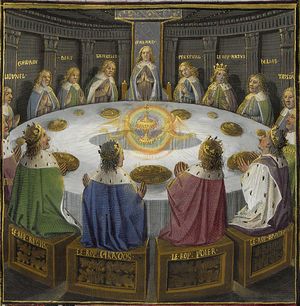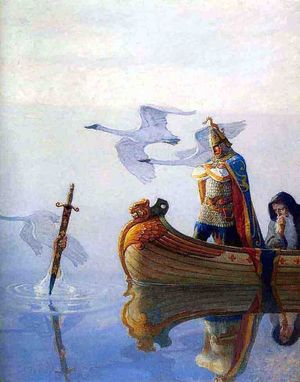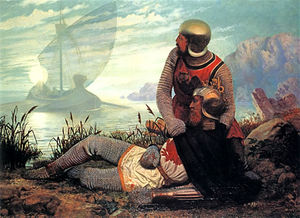Rey Arturo

The “once and future king,” fifth- or sixth-century King of the Britons and Guru of the mystery school at Camelot, an embodiment of El Morya. He drove the Saxon invaders from Britain, united the kingdom and established the order of the Knights of the Round Table, whose code of chivalry bound them to defend the helpless from the wicked and evildoers and to uphold the ideals of purity, truth, mercy, faithfulness and generosity.
Arthurian legends
Between the eleventh and fourteenth centuries, Arthurian legends attained the height of their popularity. Minstrels and troubadours carried the fame of Arthur all over Europe. Historians told of his valiant deeds in prose, and poets in verse, while artists adorned the halls, tapestries and stained-glass windows of many castles with scenes depicting the adventures of King Arthur and the knights and ladies of the Round Table.
The story of Arthur as presented in Sir Thomas Malory’s Morte d’Arthur is considered a masterpiece. Malory wrote his great work from behind bars during the Wars of the Roses (1455–86). This single book revived a vivid interest in the life of Arthur, his noble deeds, and those of his knights.
Coincidentally, in the year Malory’s book was published, Henry VII, the new king of England, announced that he himself was a descendant of King Arthur. He stated that his son, whom he named Arthur, was the fulfillment of Merlin’s prophecy—Arthur had returned to rule England.
The next great revival of interest in Arthur and his court of Camelot came as a result of the publication of the Idylls of the King by Alfred Lord Tennyson in 1842. The work was so popular throughout all the English-speaking world, that by 1890 it was taught in all public schools in the United States.
The historical King Arthur
The historical King Arthur is said to have lived about 500 A.D., and is thought to have been a leader of the Britons in their battles against the invading Anglo-Saxon kings. Malory and Tennyson both record that he fought and defeated twelve kings. Arthur was so wise a leader and performed so many deeds of valor that he became a hero to his countrymen for all time.
Some historical evidence of Arthur’s life comes from Glastonbury Abbey. Some of the priests who served there during the sixth century preserved a record of their receipt of the disinterred bodies of both King Arthur and his queen, Guinevere. The bodies of the royal couple were buried beneath the high altar in the church.
According to an account by Giraldus Cambrensis, who was present when the grave was opened at the command of Henry II about the year 1150, the grave contained the bones and sword of King Arthur. It also contained a leaden cross which contained the following inscription: Here lies buried the famous King Arthur, in the island of Avalon.
The birth of Arthur
According to Malory, Arthur was born to Uther Pendragon, “king of all England,” and noble Queen Igraine at Merlin’s own bidding with the understanding that the child would be delivered to Merlin as soon as he was born. And so the tiny newborn babe bound in a cloth of gold was brought to the “poor man” at the postern gate of the castle and taken to Sir Ector, whose wife nourished him at her own breast. Merlin called a holy man to christen him and named the child Arthur.
Within two years, while King Uther lay mortally ill, his enemies “did a great battle upon his men and slew many of his people.” Merlin bade the king to ride into the battlefield on a stretcher, for “if your person be there ... then shall ye have the victory.” So it was at St. Albans that Uther’s men overcame the “great host of the North.”
The dying king returned to London, where Merlin called together all the barons of Uther’s realm in order that the king might name his heir. And Merlin said aloud, “‘Shall your son Arthur be king after your days?’” And Uther answered, “‘I give him God’s blessing and mine’ ... wherewith he yielded up the ghost.”

The sword in the stone
The land of England stood then “in jeopardy a long while,” for many rose up attempting to capture the crown by force. So Merlin went before the Archbishop of Canterbury and counseled him to call all the lords of the realm to London at Christmas in order that Jesus, born King of Kings, might come to show who should rule England.
By the alchemy of the Christ consciousness, Merlin caused the sword and the stone to appear in the churchyard of Canterbury cathedral with these words: “Whosoever pulleth out this sword of this stone and anvil, is rightwise king born of all England.” By the trial of the sword—representing the power of the soul that is free from the bondage of attachment to things material symbolized by the stone and anvil—Arthur proved his kingship.
El juicio de la espada representa el poder del alma que es libre del cautiverio de la atadura de las cosas materiales, simbolizadas por la piedra y el yunque. Es una ilustración del derecho divino de los reyes: el que tiene el grado más alto de realización de la conciencia crística tiene el derecho de gobernar. Ni caballeros ni guerreros, reyes o nobles reunidos de entre todo el mundo occidental pudieron liberar la espada sagrada, salvo Arturo, un mozalbete de doce años. Fue coronado rey de Inglaterra por el Arzobispo de Canterbury.
Thereafter, Merlin remained at Arthur’s side as counselor and friend. The young king once would have died by the sword of mighty Pellinore had not Merlin appeared and “cast an enchantment” upon the knight. It was because Arthur’s sword was smitten in two during that fierce joust that Merlin and Arthur rode to the lake where they miraculously beheld rising from the water the arm of the Lady of the Lake holding the magnificent sword Excalibur. Merlin later counseled him, “Look ye keep well the scabbard of Excalibur for ye shall lose no blood while ye have the scabbard upon you”—a prediction well fulfilled in future years.
It was Merlin who went before King Leodegrance to announce the desire of Arthur to wed his daughter Guinevere. He returned triumphantly to Camelot with Lady Guinevere and the Round Table, a gift to Leodegrance from Arthur’s father, Uther Pendragon.

Camelot
En Camelot, el rey Arturo convocó a los hombres y mujeres de mayor grado de logro de todo el reino y formó la Orden de los Caballeros de la Mesa Redonda. Su razón de existir: la búsqueda del Santo Grial, la defensa del principio de la Madre, eterna hermandad bajo la égida del Padre Eterno, la restauración del reino de Cristo en la Tierra, la protección de la llama del Espíritu Santo en la comunidad de la corte de Arturo y su extensión por toda Bretaña, así como el ennoblecimiento del alma a través de la devoción al Cristo en la acción comunitaria individual.
Los caballeros de la Mesa Redonda y las damas de la corte de Camelot eran iniciados de una escuela de misterios de la Gran Hermandad Blanca. En la tradición de la escuela pitagórica de Crotona, la comunidad esenia de Qumrán, el mandala de Cristo y sus apóstoles, así como los gremios de la Europa medieval que le sucederían, los caballeros y damas guardaban las verdades internas de la Hermandad que Saint Germain les reveló. Saint Germain estaba encarnado como el amado Merlín, el mago de la corte y consejero del rey. Las justas y las competencias de los caballeros en sus torneos constituían la medida de los niveles de logro interior del alma.
La devoción del rey Arturo y de la reina Ginebra en su relación de gurú y chela en el plano de las almas era el foco de la llama del Dios Padre-Madre en el centro de la corte. La llegada de Lancelot du Lac, también chela de Arturo, a la Orden de los caballeros de la Mesa Redonda, constituyó la unión de las tres personas de la Trinidad, la llama trina en el corazón de Camelot. La relación en el plano de las almas de Lanzarote y Ginebra era la de llamas gemelas. Juntos, Arturo, Ginebra y Lanzarote pusieron los cimientos de la dispensación cristiano-pisciana para los pueblos de habla inglesa.
Arturo condujo a sus caballeros en la búsqueda del Santo Grial, la copa de la cual Jesús bebió en la Última Cena. Después de su ascensión, la copa del Grial fue depositada en un pozo, en Glastonbury, por un grupo de discípulos que, junto con María la Madre y José de Arimatea, viajaron en barco desde Tierra Santa para establecer santuarios en el continente europeo y en las islas británicas, para la expansión del cristianismo occidental durante el siguiente ciclo de dos mil años.
Así, El Morya, ungido por Dios (a través de Merlín, el profeta Samuel reencarnado, que ungía reyes y profetas para el pueblo de Israel), y en sintonía con el foco del Grial y por sus nobles ideales y genio espiritual, estableció la plataforma para la diseminación de la luz crística por todos los lugares del globo a donde viajaran los británicos, en su ímpetu por descubrir y establecer nuevos mundos. “La signifi cación interna de la búsqueda para los caballeros iniciados de la hermandad era buscar y encontrar la conciencia crística a través del servicio disciplinado a la vida.

Arthur’s passing
Entre los caballeros de la Mesa Redonda, Sir Modred (de quien se dice que fue hijo de Arturo, concebido antes de su matrimonio) albergaba intensos celos y odio contra el rey. Sabiendo que la fuerza militar de Arturo era insuperable, se puso en contacto con Morgana le Fay; juntos, Modred y Morgana utilizaron artimañas sutiles de brujería, traición e intriga para destruir la sagrada expectativa de rey, reina y caballeros de la Mesa Redonda. En una guerra que resultó de la negativa de pagar tributo a Roma, Arturo hubiera conquistado a la misma Roma de no ser porque fue llamado a Inglaterra, donde Modred había usurpado el trono y puesto en prisión a la reina Ginebra en la Torre de Londres. En la feroz batalla de Camlam que siguió, Arturo derribó a Modred, pero fue mortalmente herido.
According to Arthurian legends, he was placed on a barge with three queens which drifted toward Avalon, an “island valley,” where, as Alfred Lord Tennyson wrote in Idylls of the King, “falls not hail, or rain, or any snow, nor ever wind blows loudly; but it lies deep-meadow’d, happy, fair with orchard lawns and bowery hollows crown’d with summer sea.” Some accounts say that Arthur would be healed of his “grievous wound” at Avalon and would return to rule over his people.
Sir Thomas Malory writes in Le Morte d’Arthur:
Yet some men say in many parts of England that King Arthur is not dead, but had by the will of Our Lord Jesu [withdrawn] into another place; and men say that he shall come again, and he shall win the holy cross. I will not say that it shall be so, but rather I will say, here in this world he changed his life. But many men say that there is written upon his tomb this verse: Hic iacet Arthurus, rex quondam rexque futurus [Here lies Arthur, the once and future king].
The return of Arthur
Many Englishmen believed that Arthur never died. He was for them a sort of guardian angel, watching over his people from his home on the Isle of Avalon. In times of acute crisis, they believed Arthur would return to lead England to victory.
We also believe that the saint who became Thomas Becket and Thomas More was the reincarnated soul of Arthur, and that he, now ascended, is our own Guru and teacher who shows us the way of the will of God according to the path of Christ.
The Heart of the Inner Retreat is as “Avalon” where chelas of El Morya retreat in summer to be healed of the blows of karmic adversity affecting body, mind and soul. And the master himself takes refuge in this Western Shamballa—Gautama Buddha’s etheric/physical retreat in the West, an extension of his retreat over the Gobi Desert, which is centered over “the Heart” of this island valley.
Véase también
Fuentes
El Morya, El discipulo y el sendero: Claves para la Maestría del Alma en la Era de Acuario.
Pearls of Wisdom, vol. 31, no. 34, July 2, 1988.
Pearls of Wisdom, vol. 28, no. 51, December 22, 1985.
Elizabeth Clare Prophet, May 22, 1983.
Elizabeth Clare Prophet, April 21, 1984.
